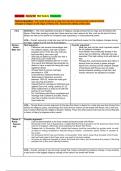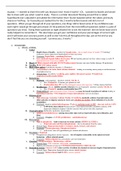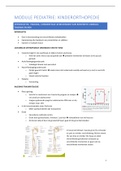Package deal
CHEMISTRY PACKAGE NOTES
From chapter 1 to 9 chemistry notes
[Show more]From chapter 1 to 9 chemistry notes
[Show more]Introductions to Acids and Bases II The Reaction of a Bronsted-Lowry Acid III Acid and Base Strength IV Equilibrium and Acid Dissociation Constants V The Dissociation of Water VI The pH scale VII Common Acid-Base reactions VIII Titration IX Buffers X Buffers in the Blood
Preview 2 out of 5 pages
Add to cartIntroductions to Acids and Bases II The Reaction of a Bronsted-Lowry Acid III Acid and Base Strength IV Equilibrium and Acid Dissociation Constants V The Dissociation of Water VI The pH scale VII Common Acid-Base reactions VIII Titration IX Buffers X Buffers in the Blood
Element - pure substance that cannot be broken down into simpler substances by a chemical reaction Dmitri Mendeleev - formulated the periodic table
Preview 1 out of 3 pages
Add to cartElement - pure substance that cannot be broken down into simpler substances by a chemical reaction Dmitri Mendeleev - formulated the periodic table
Introduction to Chemical Reactions II Balancing Chemical Equations III Types of Reactions IV Oxidation and Reduction V The Mole and Avogadro’s Number VI Mass to Mole Conversions VII Mole Calculations in Chemical Equations VIII Mass Calculations in Chemical Equations IX Percent Yield X Lim...
Preview 2 out of 6 pages
Add to cartIntroduction to Chemical Reactions II Balancing Chemical Equations III Types of Reactions IV Oxidation and Reduction V The Mole and Avogadro’s Number VI Mass to Mole Conversions VII Mole Calculations in Chemical Equations VIII Mass Calculations in Chemical Equations IX Percent Yield X Lim...
I Introduction to Covalent Bonding II Lewis Structures III Exceptions to the Octet Rule IV Resonance V Naming Covalent Compounds VI Molecular Shape VII Electronegativity and Bond Polarity VIII Polarity of Molecules IX Covalent Drugs and Medical Products
Preview 1 out of 4 pages
Add to cartI Introduction to Covalent Bonding II Lewis Structures III Exceptions to the Octet Rule IV Resonance V Naming Covalent Compounds VI Molecular Shape VII Electronegativity and Bond Polarity VIII Polarity of Molecules IX Covalent Drugs and Medical Products
Energy II Energy Changes in Reactions III Energy Diagrams IV Reaction Rates V Equilibrium VI Le Chatelier's Principle VII Body Temperature
Preview 1 out of 4 pages
Add to cartEnergy II Energy Changes in Reactions III Energy Diagrams IV Reaction Rates V Equilibrium VI Le Chatelier's Principle VII Body Temperature
I Three States of Matter II Gases and Pressure III Gas Laws IV Avogadro’s Law Ideal Gas Law VI Dalton’s Law and Partial Pressure VII Intermolecular Forces, Boiling Point, and Melting Point VIII Liquid State IX Solid State X Specific Heat XI Energy and Phase Changes XII Heating and Coo...
Preview 2 out of 6 pages
Add to cartI Three States of Matter II Gases and Pressure III Gas Laws IV Avogadro’s Law Ideal Gas Law VI Dalton’s Law and Partial Pressure VII Intermolecular Forces, Boiling Point, and Melting Point VIII Liquid State IX Solid State X Specific Heat XI Energy and Phase Changes XII Heating and Coo...
I Introduction to Bonding II Ions III Ionic Compounds IV Naming Ionic Compounds V Physical Properties of Ionic Compounds VI Polyatomic Ions
Preview 1 out of 4 pages
Add to cartI Introduction to Bonding II Ions III Ionic Compounds IV Naming Ionic Compounds V Physical Properties of Ionic Compounds VI Polyatomic Ions
I Mixtures II Electrolytes and Nonelectrolytes III Solubility-General Features IV Solubility-Effects of Temp and Pressure V Concentration Units-Percent Concentration VI Concentration Units-Molarity VII Dilution VIII Colligative Properties IX Osmosis and Dialysis
Preview 1 out of 4 pages
Add to cartI Mixtures II Electrolytes and Nonelectrolytes III Solubility-General Features IV Solubility-Effects of Temp and Pressure V Concentration Units-Percent Concentration VI Concentration Units-Molarity VII Dilution VIII Colligative Properties IX Osmosis and Dialysis

Stuvia customers have reviewed more than 700,000 summaries. This how you know that you are buying the best documents.

You can quickly pay through credit card or Stuvia-credit for the summaries. There is no membership needed.

Your fellow students write the study notes themselves, which is why the documents are always reliable and up-to-date. This ensures you quickly get to the core!
You get a PDF, available immediately after your purchase. The purchased document is accessible anytime, anywhere and indefinitely through your profile.
Our satisfaction guarantee ensures that you always find a study document that suits you well. You fill out a form, and our customer service team takes care of the rest.
Stuvia is a marketplace, so you are not buying this document from us, but from seller siyenaart. Stuvia facilitates payment to the seller.
No, you only buy these notes for $35.49. You're not tied to anything after your purchase.
4.6 stars on Google & Trustpilot (+1000 reviews)
75463 documents were sold in the last 30 days
Founded in 2010, the go-to place to buy study notes for 15 years now








